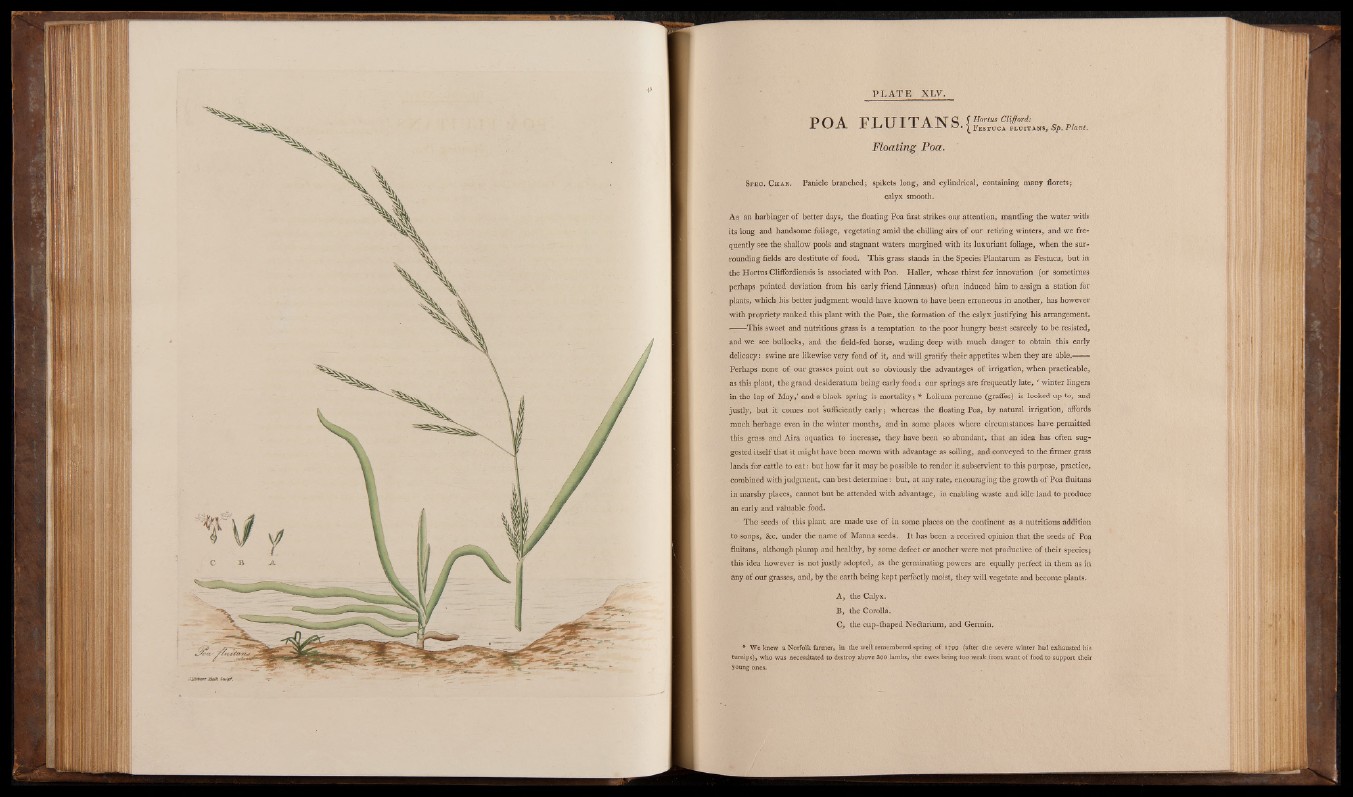
P O A PT TTTT *- -*-* '-J J- -»- A -T1A*V S J^ Fflebsrti“uscCaT f^louri*tans,- £?p. Plant.
Floating Poa.
Spec. Char. Panicle branched; spikets long, and cylindrical, containing many florets;
calyx smooth.
As an harbinger of better days, the floating Poa first strikes our attention, mantling the water with
its long and handsome foliage, vegetating amid the chilling airs of our retiring winters, and we frequently
see the shallow pools and stagnant waters margined with its luxuriant foliage, when the surrounding
fields are destitute o f food. "This grass stands in the Species Plantarum as Festuca, but in
the Hortus Cliffordiensis is associated with Poa. Haller, whose thirst for innovation (or sometimes
perhaps pointed deviation from his early friend Linnaeus) often induced him to assign a station for
plants, which.his better judgment would have known to have been erroneous in another, has however
with propriety ranked this plant with the Poae, the formation of the calyx justifying his arrangement.
■ -This .sweet and nutritious grass is a temptation to the poor hungry beast scarcely to be resisted,
and we see bullocks, and the field-fed horse, wading deep with much danger to obtain this early
delicacy: swine are likewise very fond of it, and will gratify their appetites when they are able. • -
Perhaps none of. our grasses point out so obviously the advantages of irrigation, when practicable,
as this plant, the grand desideratum being early food: our springs are frequently late, f winter lingers
in the lap of May,’ and a black spring is mortality; * Lolium perenne (grades) is looked up to, and
justly, but it comes not sufficiently early; whereas the floating Poa, by natural irrigation, affords
much herbage even in the winter months, and in some places where circumstances have permitted
this grass and Aira aquatica to increase, they have been so abundant, that an idea has often suggested
itself that it might have been mown with advantage as soiling, and conveyed to the firmer grass
lands for cattle to eat: but how far it may be possible to render it subservient to this purpose, practice,
combined with judgment, can best determine: but, at any rate, encouraging the growth o f Poa fluitans
in marshy places, cannot but be attended with advantage, in enabling waste and idle land to produce
an early and valuable food.
The seeds of this plant are made use of in some places on the continent as a nutritious addition
to soups, &c. under the name of Manna seeds. It has been a received opinion that the seeds of Poa
fluitans, although plump and healthy, by some defect or another were not productive o f their species;
this idea however is not justly adopted, as the germinating powers are equally perfect in them as in
any of our grasses, and, by the earth being kept perfectly moist, they will vegetate and become plants.
A, the Calyx.
B, the Corolla.
C, the cup-fhaped Ne&arium, and Germin.
* We knew a Norfolk former, in the well remembered spring of 1790 (after the severe winter had exhausted his
turnips), who was necessitated to destroy above 300 lambs, the ewes being too weak from want of food to support their
young ones.